Swiss Schmutzlis unmoved by Dutch Zwarte Piet row

It is a big job distributing presents to children, but St Nicholas’s choice of assistants is coming under scrutiny. Concern over the Dutch blackfaced Zwarte Piet has reached the United Nations. He resembles a bogeyman seen in some parts of Switzerland.
It’s the night of the first Sunday of Advent and people have turned out to witness the traditional arrival of St Nicholas of Myra – or Samichlaus as he is known locally – in Chur, eastern Switzerland.
A number of Samichlaus and their helpers, known as Schmutzli (“dirty fellow”), gather in front of the cathedral and then march in a torchlight procession down into the city. The Schmutzlis’ faces have been painted black, as is local tradition.
The local group’s chairman, Marcel Leupi, says he was able to muster 20-30 Samichlaus-Schmutzli pairs who will visit children with gifts on December 6. Children are told to be good, otherwise Schmutzli will leave coal instead of treats or switches to spank them with – or even carry them off in his sack.
At the procession, children along the route all look happy. One Schmutzli, Roland Conrad, pooh-poohs the idea that his appearance may frighten children. Christian Foppa, a mitred St Nicholas, and his own Schmutzli agree.
“I remember once we visited a family where the kids were a bit afraid,” Foppa recalls. “Schmutzli here saw a toy tractor on the floor and asked whose it was. One little boy said it was his. Schmutzli told him he drove a big tractor himself – and the ice was broken.”
Foppa adds that Schmutzlis are indispensable. “Without Schmutzli, Samichlaus would be nothing,” he says with a hearty laugh.
St Nicholas, Bishop of Myra, patron saint of children, comes on the eve or the day of his feast, December 6, bringing presents for children. He is accompanied by his assistant, Schmutzli in German or Père Fouettard (“Old Whipper”) in French.
There may be more than one of these assistants. The saint comes riding on a horse or a donkey, or these days, more likely on foot, having parked down the road. He carries a sack of oranges and nuts and other goodies, but also a big ledger book, which he consults to “find out who’s naughty and nice”.
Unlike Santa Claus, who is never actually seen on his rounds, and whose existence has sometimes been questioned, St Nick and Schmutzli deliver gifts in person to Swiss children.
Everywhere that the custom is observed, there are local St Nicholas clubs whose members dress the part and pay visits to families, kindergarten classes, and so on. They can be booked with a phone call. Many explicitly guarantee not to frighten children.
How St Nick and Schmutzli actually look depends on local custom. In Catholic areas, St Nick looks like a bishop, with a mitre and crozier, and may be dressed in white or red. In Protestant areas, he is more likely to be a red-suited figure with a hood. Schmutzli usually wears something like a brown Franciscan monk’s habit with a cowl over his head. He is bearded like St Nick and in some parts has a blackened face.
Negative stereotype
In recent times, with the gory fairy tales of the Brothers Grimm and other traditional features of childhood being watered down, Schmutzli has had to have something of a makeover. He now appears as a benign assistant to St Nick in doling out presents.
His equivalent in The Netherlands, Zwarte Piet (Black Pete), is falling foul of political correctness. Critics say he is racist and demeaning and obviously a black servant or slave from the bad old days of Dutch imperialism.
Defenders of the custom claim he is blackfaced from bringing presents down chimneys, but his whole get-up is unmistakeably one of a gollywog.
Last month a group of human rights experts in The Netherlands called on the government to facilitate the growing national debate on whether the portrayal perpetuates a negative stereotype of Africans and people of African descent.
“It is clear that many people, especially people of African descent living in the Netherlands, consider that aspects of Zwarte Piet are rooted in unacceptable, colonial attitudes that they find racist and offensive,” the experts said in a UN press release.
“Indeed, since the debate over Zwarte Piet has escalated, people of African descent report being subjected to even greater racial abuse and ridicule, actions which we condemn.”
They noted suggestions about how the best aspects of the tradition can be preserved and how elements that offend might be modified, and called for the government to facilitate an “open debate in Dutch society, with a view to creating an understanding of how this tradition is perceived by different groups and to identify steps that might respond to the views and concerns of all”.
The issue has had echoes in Canada too, where a politician with a Dutch wife faced a backlash for posting and then deleting a photo of himself with a Zwarte Piet on Twitter.
St Nicholas comes on December 6 in many parts of Europe, but the custom is most elaborately developed in The Netherlands and Dutch-speaking Belgium. Here, St Nicholas comes by ship from Spain and starts distributing presents a full week before December 6, accompanied by his trusty companion, Zwarte Piet.
This year Zwarte Piet has aroused the ire of a working group of the UN High Commission for Human Rights, on grounds of racist stereotyping. Dutch Prime Minister Mark Rutte was reported by newspapers as shrugging it off, saying “Zwarte Piet is black, and there’s not much we can do about it”.
St Nick in Dutch is called “Sinterclaas”, which seems to be the origin of the American Santa Claus, via the Dutch colony of New York, formerly New Amsterdam.
St Nicholas also comes visiting in much of Germany, where Schmutzli is known as Knecht Ruprecht (or some local name). Then again, Knecht Ruprecht may come on Christmas Eve and leave presents on behalf of the Christ Child.
In southern Europe, the presents for children usually come on the Epiphany, the 12th day of Christmas. In Spain, they are brought by the Three Wise Men, and in much of Italy and Italian Switzerland by La Befana, a witch with a broomstick. In Greece, on the other hand, it is St Basil who comes bringing presents on his feast-day, January 1.
On the wane?
According to Lucerne folklorist Kurt Lussi, the fact that the Swiss bogeyman is blackfaced has nothing to do with racism. “Black symbolises the demonic and unfruitful, as opposed to white, the colour of the holy and immaculate,” he explains.
As Lussi points out, though, Schmutz in German originally meant not dirt but grease. In olden days grease was mixed with soot to paint Schmutzli’s face. Today’s Schmutzlis do not have to be blackfaced. For Lussi, the whole tradition is waning, and current images of St Nick “are as much influenced by Coca-Cola ads as by the saint of Myra”.
Back in Chur, one Schmutzli, Roland Conrad, says that Zwarte Piet is different because he is a Moor from Spain, so people would more likely think he was black.
When asked where Schmutzli comes from and why he has a black face, Conrad and Samichlaus Foppa have no shortage of stories.
In one, Schmutzli was a lumberjack and charcoal-burner in the woods above Chur. One December 6 night, St Nick had a hole in his sack and lost all the oranges and nuts. But Schmutzli had found a trail of them in the snow and collected them in his sack, and so the day was saved.
Some say Schmutzli was shunned by people because of his blackened face and solitary life in the woods. St Nick felt sorry for him and invited him to come and be his helper.
The taming of Schmutzli
In Switzerland the tradition varies by denomination: in Catholic areas St Nicholas appears as a bishop with mitre and crozier, while in Protestant areas, where the custom was only revived in the 19th century, he is not really a Catholic saint – abolished by the Reformers – but a secular figure.
According to Lussi, St Nick and Schmutzli in Central Europe really go back to pre-Christian myth. The St Nicholas figure is a Christianisation of Wotan, who is a god of winter storms on a white horse, leading the host of the unredeemed dead to the Other World through the winter landscape, with Schmutzli as his helper, the whipper-in of the ghostly herd (he later became a bogeyman). But that is also why St Nick judges good and bad behaviour – for Wotan is the judge of the dead.
There is a move to tone down Schmutzli, Lussi agrees. “The racism accusation in The Netherlands is only a part of a general trend” to sanitise the old folk customs. The other part is to tone down the scariness of Schmutzli. He is degenerating into a kind of Christmas Fool.
When Lussi was a child, he remembered Schmutzli being much scarier. His mother even told stories of being tossed in a sack and so on. “If that happened today, there might be criminal charges and psychological treatment would be called for,” he chuckled.
However, “when you see the children’s eyes light up on seeing the arrival of Samichlaus and Schmutzli, they do not seem afraid at all – it is more likely parents who get anxious”, he adds.

In compliance with the JTI standards
More: SWI swissinfo.ch certified by the Journalism Trust Initiative



You can find an overview of ongoing debates with our journalists here. Please join us!
If you want to start a conversation about a topic raised in this article or want to report factual errors, email us at english@swissinfo.ch.